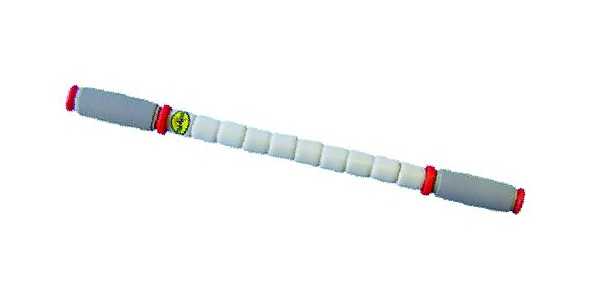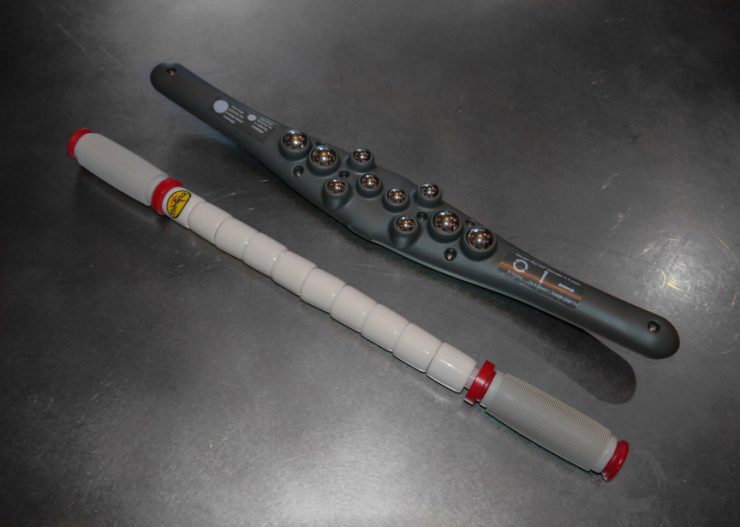Sports Massage Tool Reviews
Dissipating lactic acid, breaking down scar tissue around the IT band, and generally making those tired muscles feel less fatigued. Sports massage products make these promises. But just how well do they deliver? We’ve used a bunch over the years – from the standard foam roller to a freshly minted Moji 360. Here are three tools that get the job done:
Moji 360 Massager

Moji got their start back in 2007 and now builds a range of products including cold compression, heat therapy and massage products. The Moji 360 Massager falls into the latter category. It consists of a heavy-duty plastic handle about 18 inches long, wide in the middle and narrow at the ends. In that middle section, Moji places three sets of stainless steel ball bearings. The interior set of six spheres are small, about half and inch in diameter. The outer sets – located on either side of the interior six – consist of two spheres each and are approximately an inch in diameter.
Moji says the larger spheres provide more deep tissue massage while the smaller ones deliver relaxing massage. Frankly, we found no difference between the two sizes when actually using the Moji 360. Those spheres allow for up-and-down, side-to-side and circular massage which is quite an advantage over other products. The spheres did a nice job on the upper thigh, calf and lower back (the handle is just long enough to cover that area). You can cover the neck as well, but shoulders go lacking because of the short handle. About $50. Find them at REI.
Final Verdict:
[Rating:4/5]
The Stick Massager

The Stick is made by the guys at RPI Intracell in Atlanta, a group that got their start in the market back in the early 1990s. Today, the company manufacturers specific products to help with carpal tunnel, lumbar and foot issues. Like the Moji 360, the Stick is approximately 18-inches long. Unlike the Moji, it’s a consistent 1.25 inches in diameter. Instead of circular steel spheres, the Stick consists of plastic bands that wrap a flexible central rod. On either end are rigged handles for easy gripping.
The Stick does a nice job of massaging the muscles of the upper thigh, calf and neck. Because of the product’s design, the Stick only really allows for an up-and-down motion. Although more limited than the Moji, the massage is still effective at reducing fatigue and soreness. About $35. Available at TriVillage.
Final Verdict:
[Rating:3/5]
Foam Roller Massager
The foam roller gained popularity in the mid-1990s and now can be found in an almost endless array of variations. There come in red, white and blue, orange, green, pink and black. Often these indicate the relative firmness of the roller with white being the least and black being the most firm. In addition, there are rollers with ridges, rollers with bumps, and rollers with “Y”s carved into them. They come in various sizes too, most are six inches in diameter but can range in length from 12 inches to 36 inches. And they range in price from just a few dollars to more than $40 depending on the brand and features.
For me, the foam roller has been a go to massage tool for years. It not only helps soothe tired muscles but also provides invaluable therapy when battling IT Band Syndrome. Last year, I was hobbled by that painful issue and rolling from hip to knee on a foam roller broke up scar tissue and got me back on the road. Like the Stick, you get only the up-and-down motion but because of the longer lengths you can hit just about every part of the body – from calf to neck and everything in between. Starts at $10. Available at Amazon.
Final Verdict:
[Rating:4.5/5]





